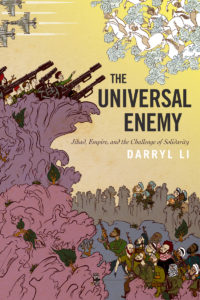I didn’t see it when Nadir describes he and his wife departing Banja Luka at the end of a classmate’s gun, or when Fadhil chainsmoked his way through a bitter rendition of his family tree. It wasn’t until page 195, when Darryl Li visits Abu Hamza in an immigration prison, a sack of pears for the hunger strikers in hand, that The Universal Enemy truly emerged as a methodological wonder. By that time, Li had proven his case, that to understand universalism and the challenges other projects of universality posited to the shape and meanings of solidarity, required a peripatetic ethnographic approach.
This is a history of the everyday life of the Bosnian jihad, and of the tribulations of those who staked their lives to a project of their own making for a new kind of vision of the world. It is about lives and figures at the edges of international legal frames, ebbing in and out of capture by international and nation-state actors seeking to disappear, exile, punish, detain, expel, redact, break, or kill them.
Li could not have set out a more difficult methodological task. To write an “ethnographic history from below–one that unfolds across different regions and seeks grounding in local contexts without being limited to them,” is to already set several complicated tasks. One, to ingather materials by those who often leave very little behind, or whose records have been destroyed or put under impenetrable lock and key. Two, to read these archival shards against each other across starkly disparate geographies and contingencies, let alone languages, populations, states, and formations. Third, to do so in such a way as to not veer into a compromised position vis-a-vis an international order hostile to the subjects and producers of these archival shards. Any possible rendering of them as historical subjects, with lives, desires, and life-worlds living and working “beneath and between” states, exposes one to an accusation of seeking to redeem the irredeemable, to entertain the terrible.
Three exercises in Li’s methodological creativity bear particular mention. I divide them not in terms of archival form, document, interview, or legal file, but as pathways Li uses to read this universalist project from below. Li writes of these fighters as storytellers, and tellers of their own story. He excavates the life-worlds of texts and their receptions, and maps the treacherous, joyous, transits of trepidation and estrangement. With these forms, he builds a forbidding armature against easy pieties, essentialist banalities, and political or ethical condescension (whatever one might think of the jihad project itself).
Texts
These mujahids lived by codes, some written in texts, some produced through negotiation of interpretive doctrine, all contingent on belief, location, and attachments. “Differences,” Li tells us, “are never solidified nor extinguished, but continuously mediated and processed as long as they share a common ground.”
Li introduces us to several of these key texts, their circulations, formulations, translations, authors, and readers. This might sound like a mundane archival exercise, but what shines here is the novelty of situating what has often circulated as “common” texts into their particular receptions. He masterfully unravels the story of Imad El-Misri’s “Notions That Must Be Corrected,” a ubiquitous jihadist pamphlet, and reweaves it as a text whose analytical purchase power rests less on what it says, than how it was built, read, collaboratively produced, and used. Mehmud, a factory worker turned jihadist, for example, told Li it is popular because it is uncomplicated, a simple, easy to carry and to use, chapbook. How unlike the instrumentalization of these texts as hermeneutic artefacts in so much jihadism, and indeed Islamism, studies. Li oxygenates the often breathless textual studies by jihadism experts of several foundational jihadist works, and he does so by front-ending production and circulation as a method through which to understand their ideological purchase to those meant to embody and enact their directives and advice.
Transits
At some point, as Li walks into a Jeddah office building to meet Abu Abd al-Aziz, I began to feel homesick for Bosnia. As the cast of characters accumulates travel, zigzagging between Britain and Jamaica, Tunis then Italy then Bosnia and then back to Tunis, Li offers a method for writing about dislocation and estrangement, or ghurba, I had not quite seen in refugee, migration, and exile literature. Often, the method is to situate oneself in one site, a camp or detention center, or to follow one or two subjects on their journey. Migration studies can sometimes fixate on departure and arrival, writing linear histories of incorporation or rejection, elucidating the politics of belonging and identity, labor and class mobility. How can these histories of frenetic motion, upheaval, and violence not collapse into incoherence? Instead of tracing the characters, it is the universalism itself that is followed and traced, and the commitment and the virtues, or akhlaq, it produces.
It is not lost on me that such a method also offers a pointed rejoinder to histories of revolutionary and radical leftist movements, in the Middle East and elsewhere, pushing further forward a proposition that it is indeed possible to write a history of a struggle without dropping the everyday, losing the plot in party machinations, or in excruciatingly tedious explications of ideological hairsplitting.
Tales
Twenty-eight self-described mujahids were Li’s network of interlocutors, seventeen foreign, eleven Bosnian. We do not meet the book’s protagonists all at once, but instead are introduced to them as Li’s ethnography arrives at their location, or steps into their realm of expertise or narration of events. These stories are juxtaposed against shards of archival retrieval across multiple international institutions, Li’s legal training allowing him to access and read war crimes tribunal materials amongst much else. But at the heart of this ethnography are these figures, each etched sensitively, humanely, yet with some remove, a successful feat of narrative dexterity. Li meets them in coffee shops and cemeteries, at home, and as we learn, in immigration prison.
Vividly drawn as these characters are, Abu Al-Harith, Arsalan, Muhsin, Abu Hamza, Ayman, Mahdi, and Abu Ali, also narrate the war, and their world within it. Li both tells their story, and in tender exquisite passages, allows these men to recount their own tales. Miracles, karamas, are recounted and taken seriously in a cosmology for commitment. Li doesn’t go into much detail about his use of storytelling devices, but it is not happenstance either. The book begins with a cast list, a dramatis personae, that already achieves a listening posture in the reader, or at least, me. There is an ethical frame to such a structure. It calls on the reader to suspend judgment for a moment, give the narrator and his characters a chance to tell their story, and hopefully, if not entertained, one emerges with a sense of having entered a familiar realm anew, seeing it through the eyes of those we never thought were human, let alone funny, clever, cheeky, stern, sometimes sardonic, sometimes merciless, perhaps innocent, perhaps not so, but in any case, deserving a hearing.
It is perhaps then why page 195 comes as such a throat-clenching surprise. It is then when we fully come to realize that many of these men were not interviewed by Li in situ, but on the run, or imprisoned, ensnared in a Global War on Terror that has no use for seeing them as anything but bodies for disposal, as excesses of war. It is a complicated moment. The conditions of narration come into view, and I was productively rattled. The war has not ended for these mujahids, but they are now noncombatants in a war against them. Projections and impressions, positionalities of interviewer and interviewee, come into a relief that points to the hall of mirrors any writing on a universalist project will require a scholar to enter.
Pointing to these methodological innovations is sometimes assumed to give a piece of scholarship short shrift, a way of diminishing possible theoretical or analytical contributions. Far from it. What I hope to offer by way of this short meditation on Li’s methods is a gesture toward how it produces, or advances, theory. Li seeks to offer a different study of universalism by way of the Bosnian jihad and its others, his methods an improvised piecemeal retrieval of archives and a sustained, decade-long oral historical, ethnographic, commitment to a network of interlocutors. This is no one-year stint in a field site. It is slow, dangerous, both for Li and his subjects, laborious, and infinitely contradictory and complex work. I did not close the book with a satisfied sense of having gained some mastery of a question, or a place, or a time, though I learned enormous amounts of information, and gained a completely new mapping of the universal. Rather, what Li’s methods told me is something altogether more circumspect and in that circumspection, more powerful: as the world roils, who are we listening to? Should we find others? If so, are we ready to hear what they have to say?














